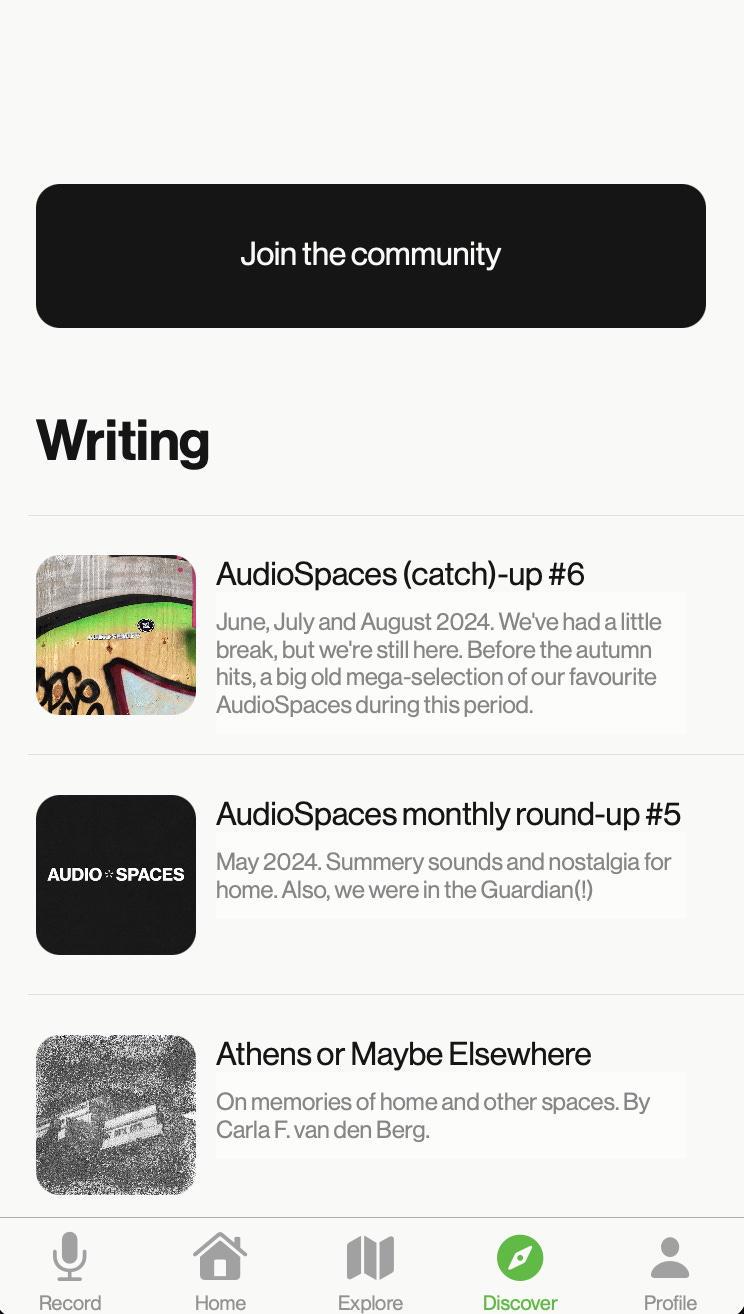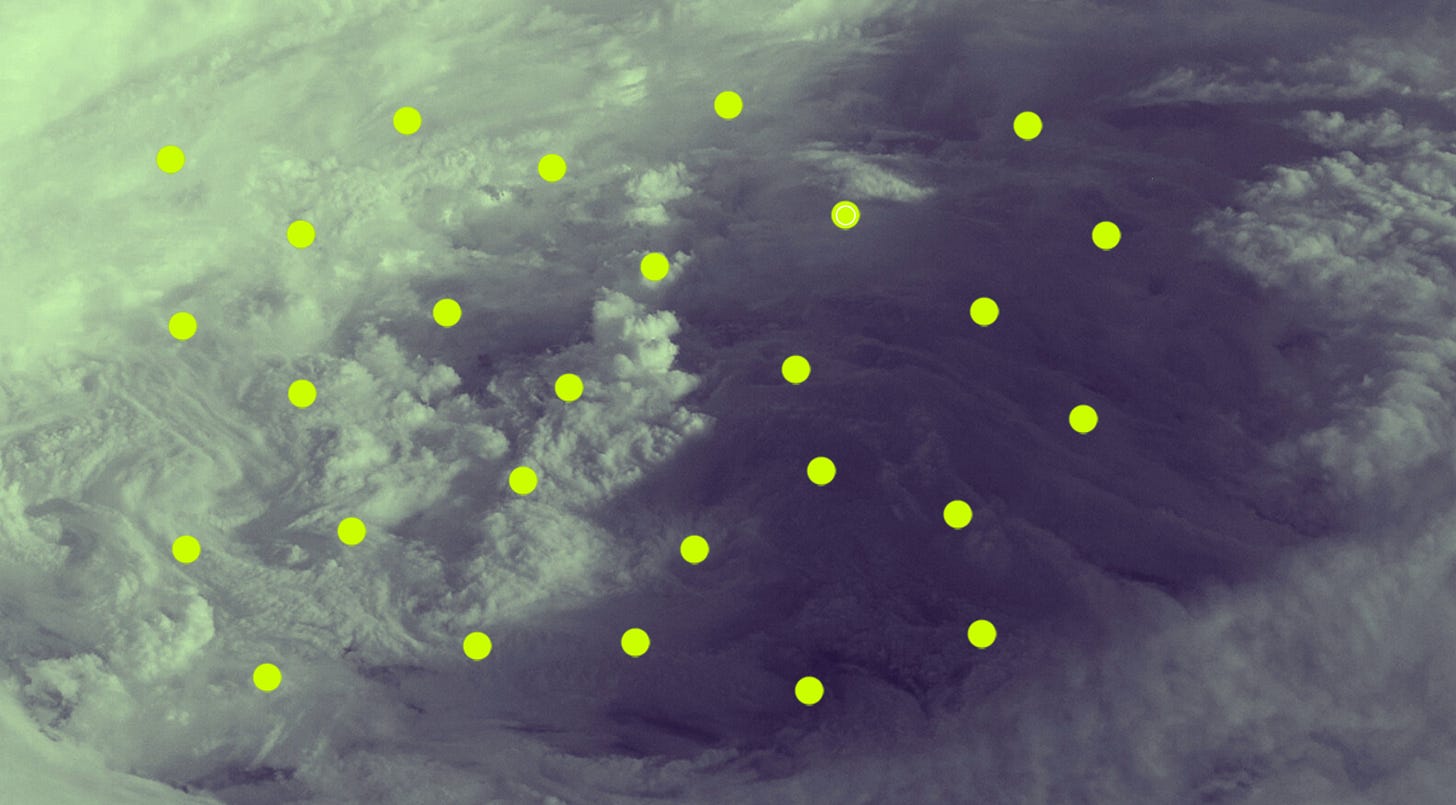Morning everyone. The leaves are fading ever yellower, the sky is a damper, greyish-white, and my hands are cold. It must be autumn in the UK. It’s also over a week into October already, so before you start answering emails again, we have September to catch up on. First things first, some of our favourite uploads from last month.
AudioSpace(s) of the month
How do we choose which audio we want to highlight from each month? Well, there are a variety of things that might catch one’s attention. Sometimes it’s a location, like in mánav’s capture of Monteiro Vaddo, Goa or stalefroot’s Atlantic shore sounds in Loire. Every month there’s also always some really nice natural acoustics, like that of the Rio Guadiana recorded by madalena or matt shenton’s very creaky tree in the wind.
Another feature is just things that sound intriguing in and of themselves—in such a way that you can even detach from whatever it is that’s actually being recorded (one day we’ll talk about reduced listening). This month one of my favourites was the jabber of salon antropología by katia, plus k w e r t c h a ’s immersive clip of a Salerno railway station.
In other cases it can just be the name of an AudioSpace that’s genius, or the simple idea of recording something that I’d never imagine to record—like what I understand to be maddy reading Edward Said in silence for six minutes, which I really love. Or maybe it’s how a particular AudioSpace sits amongst the rest of someone’s shared uploads, or in a collection.
To be honest, it’s usually just a combination of most or all of these things. The strange sounds that keep on making their way onto the map, week after week, never cease to impress.
29.08.2024 Afternoon
by mánav 🇵🇹🇮🇳
Tansforming pleasure in tokyo
by siobhan
Said, E. ‘Michel Foucault, 1926-1984’ pg.5
by maddy
A very creaky tree moving in the wind on the bank of the river Stour
by matt shenton
Rio Guadiana at sunset
by madalena
Regional Train Approching and Departing Salerno Rail Station
by k w e r t c h a
For those of you new to the newsletter (welcome, by the way!), these links above will take you straight to the individual AudioSpaces in the app. We’re still working on getting the Android version out there, so sadly for now it will only work if you’re on iPhone. Don’t worry, though: a lot of these picks get posted on our Instagram for everyone to have a preview.
App updates
If you’ve opened AudioSpaces recently, the main change you might have noticed is a new Discover tab. This displays everything we post on the newsletter, just in case you missed them in your inbox. This makes it easier than ever to browse all the extraneous things we’re doing to support what goes on in the app.
Here you’ll also find a link to join the WhatsApp Community we recently set up. We’re testing this as an easier communications channel for you all to share feedback, suggestions, ideas, or anything interesting you think the rest of us might want to discover. We’ll also post live updates here when anything major happens.
Some users have noted an issue signing up to the app with their phone numbers. Sorry about this, and for most of you the issue should now be solved. When there’s something not quite working, don’t hesitate to get in touch—but the first thing I’d always suggest is to check if you are updated.
Other things to explore
Finally, it’s been a while since we’ve done any recommendations in the newsletter. Here are three things to dig your teeth (your ears?) into.
A beginner’s guide to field recording
It’s hard to miss how many users are testing out AudioSpaces as a tool to capture everyday acoustic environments: nature sounds, urban ambiences, wide soundscapes and so on. One simple way to think about this kind of recording is that it’s less focused on what the recordist is doing—in fact, they’re usually imperceptible. Rather, this audio aims to lay bare the world “out there”, or at least how it sounds to us.
This, in its most basic sense, is what we call field recording—an activity about which lots can be said, and we’ve touched on it a couple of times in the newsletter. If you’re that way inclined, there does just seem to be something compelling about how sounds and spaces are so closely tied together. This is exactly what field recording can reveal, in ways that words never really could.
Just a hunch, but some of you might be interested in deepening your practices in “the field”. I’m not really thinking here about the nuts and bolts of how to make better recordings (whatever that means—but that’s a chat for another time), but rather that it might help to ask: where does this well-established audio practice come from? What’s its history?
To begin answering these questions, you could do worse than this article by the composer Lawrence English. Also, while you read, why not have a listen to some of Jana Winderen’s underwater field recordings, like these ones of Nordic shrimps just going about their business?1
Mapa de sueños sonoros
Field recordings are great, but what I love about the app is that an AudioSpace can be all sorts of things. Sound comes in many different forms. It comes at us in waves and drags us along with it in multiple vibrational directions. Because sound is everywhere, recorded audio can speak to a whole range of life’s elements, from the concrete everyday to the ephemera of dreams.
On that note, Fernando Godoy, a Chilean sound art legend who’s directed the Tsonami Festival since 2007, has made a “fictional” map comprised entirely of dreams. Or, to be more precise, the map is made up of dreams as they are orally recounted by different contributors. These dream-tales—usually with sound as some central theme in them—are pinned interpretively onto a cloud, as you see below. This one’s admittedly more accessible for Spanish and Portuguese speakers, but the idea itself is worth everyone’s attention.
We’ve been considering how we might use AudioSpaces as a dream-telling tool for a while. There’s actually a collection on the app already, which I encourage you all to add your dreams to, but it’s something that would be exciting to go further with. Give us a shout if you have an idea!
Unsound Dispatch
We don’t talk about music all that much on this newsletter—there are already loads of good writers that do. Besides, we’re especially interested here with the much wider ways that sound shapes our lives. This includes, but goes beyond, music. How might interacting with sounds change our relationships to the everyday spaces around us? What are the effects of recording audio? What are the limits of listening?
Unsound is a (mainly electronic) music and arts festival, but for me it always seems to address those kinds of questions which drive AudioSpaces forward. This year’s edition in Kraków—with the theme of NOISE—actually finished last Sunday, so recommending the festival itself wouldn’t be of much use right now.
But as of last year they have a Substack, which covers the festival but also pads that coverage out with what is usually some really interesting writing. They also give a lot of exposure to the outer edges of sonic culture, so I’m always finding weird new gems. For example, from their last post, how nice is this by Piotr Kurek?
Lots of things to explore on and with your screens this month. Don’t forget to untether yourself for a bit, though, and go pay some attention to the really-real world. Also put some gloves on x x
She’s using an underwater mic called a hydrophone to make these recordings—don’t put your phone in the sea.







